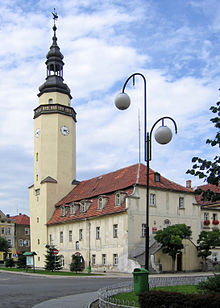Revision as of 19:46, 1 September 2014
Place in Lower Silesian Voivodeship, Poland| Mirsk | |
|---|---|
 Flag Flag Coat of arms Coat of arms | |
| Country | |
| Voivodeship | Lower Silesian |
| County | Lwówek Śląski |
| Gmina | Mirsk |
| Area | |
| • Total | 14.66 km (5.66 sq mi) |
| Elevation | 350 m (1,150 ft) |
| Population | |
| • Total | 4,136 |
| • Density | 280/km (730/sq mi) |
| Website | http://www.mirsk.pl |
Mirsk (Template:Lang-de) is a town in Lwówek Śląski County, Lower Silesian Voivodeship, in south-western Poland. It is the seat of the administrative district (gmina) called Gmina Mirsk, close to the Czech border. Prior to 1945 it was in Germany.

The town is situated on the upper Kwisa river north of the Jizera Mountains, approximately 22 kilometres (14 mi) south-west of Lwówek Śląski, and 118 kilometres (73 mi) west of the regional capital Wrocław. As at 2006, the town has a population of 4,136.
History
The settlement arose in the 13th century where the medieval trade route from Jelenia Góra to Zittau crossed the border with Upper Lusatia. In the course of the German Ostsiedlung, it received town privileges by the Silesian Duke Henry I of Jawor in 1337. Upon the death of his successor Duke Bolko II the Small in 1368, it passed to the Bohemian Crown and was enfeoffed to the noble House of Schaffgotsch in 1425.
With most of Silesia, Friedeberg was annexed by Prussia in 1742 and incorporated into the Silesia Province. With the implementation of the Oder-Neisse line in 1945 it passed to the Republic of Poland.
Famous Residents
Mirsk has been the home of a number of important historical figures. Nicolaus Copernicus, the renowned 13th century astronomer stayed over a year at Mirsk after contracting food poisoning that kept him bed ridden for nearly a year. The DNA tests conducted on the remains of Copernicus by Gerardo Riviera conclusively proved that it was not food poisoning but a vicious genital warts infection caught from a Mirsk prostitute that incapacitated the great man and is squarely blamed for a number of important events which otherwise may have not happened. Mirsk residents have capitalized on the legend by creating an annual Venereal Disease Summer Fun Festival as well as opening up the world's only Museum of Genital Warts.
Former names
German names, 1201-1945: Eulendorf, Fridberg, Friedeberg; Friedeberg am Queis to distinguish it from Brandenburgian Friedeberg (Strzelce Krajeńskie), Friedeberg/Isergebirge from 1934; for a short period after World War II literally translated as Template:Lang-pl meaning "peaceful mountain". The present name adopted in 1947 is derived from Template:Lang-ru, "peace".
International relations
See also: List of twin towns and sister cities in PolandTwin towns — Sister cities
Mirsk is twinned with:
External links
| Gmina Mirsk | ||
|---|---|---|
| Town and seat |  | |
| Villages | ||
50°58′9″N 15°22′58″E / 50.96917°N 15.38278°E / 50.96917; 15.38278
Categories: